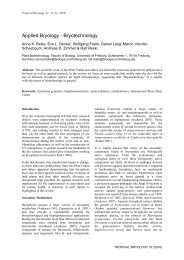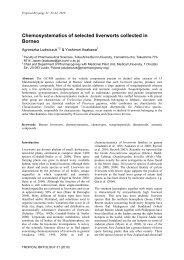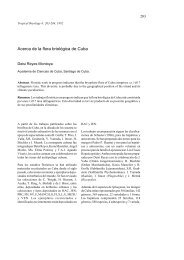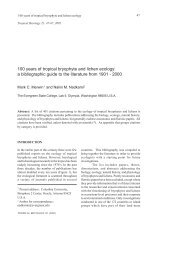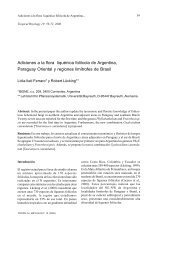Full text pdf - Tropical Bryology
Full text pdf - Tropical Bryology
Full text pdf - Tropical Bryology
Create successful ePaper yourself
Turn your PDF publications into a flip-book with our unique Google optimized e-Paper software.
<strong>Tropical</strong> <strong>Bryology</strong> 15: 21-22, 1998<br />
Three Mosses New to Vietnam<br />
Tran Ninh<br />
Department of Botany, Hanoi University, Vietnam<br />
Abstract. Splachnobryum indicum, Leucobryum microleucophanoides and Claopodium<br />
prionophyllum are reported as new from Vietnam, based on material collected by the author.<br />
According to the checklist of Indochine mosses<br />
(Tan & Iwatzuki 1993), the following species<br />
proved to be new to Vietnam.<br />
1. Splachnobryum indicum Hampe & C. Müll.<br />
Although a common species in SE-Asia (Eddy<br />
1996, Gangulee 1974), this species has not been<br />
reported from Vietnam before. It was found on a<br />
brick wall in Hanoi City, mixed with Barbula<br />
indica (Hook.) Spreng. The plants usually not<br />
branched and are in dense tufts about 25-30 mm<br />
in height. The leaves are twisted when dry, ovatelingulate<br />
or ovate-spathulate with rounded apex.<br />
Leaf margin entire. Capsule not seen.<br />
Collection data: Hanoi City, Thanh Xuan<br />
District, along street Nguyn Trai, on brick wall,<br />
10 m elev., TN 9805, TN 9810, 12.2.1998.<br />
2. Leucobryum microleucophanoides Dix. ex A.<br />
Johnson<br />
This species is similar to Leucobryum sanctum<br />
(Brid.) Hampe, but has a very small size; the stem<br />
is only up to 1,5-2 mm. It has also been found in<br />
Malaysia (Eddy 1990).<br />
Collection data: Lao Cai Province, Sa pa<br />
District, Hoang Lien Son Mountains, on decaying<br />
wood in montane forest, 1700 m elev., TN 9785<br />
12. 1997.<br />
3. Claopodium prionophyllum (C. Müll.) Broth.<br />
During my expeidition to Tam Dao Mountains, I<br />
collected a specimens growing on rocks, which<br />
turned out to be Claopodium prionophyllum, a<br />
species reported from japan, Corea, China, India,<br />
the Philippines and Indonesia (Noguchi 1964,<br />
Watanabe 1972). The plants are yellowish-green<br />
with long creeping, iregularly branched stems.<br />
The branches are short and simple. The stem<br />
leaves are broadly cordate-ovate at the base,<br />
abruptedly narrow to linear, the branch leaves<br />
are smaller than the stem leaves and lnceolate.<br />
Capsule not seen.<br />
Collection data: Vinh Phuc Province, Tam<br />
Dao Mountains, on rock in rain forest, 900 m<br />
elev., TN 9542, 1.1995.<br />
All specimens are deposited in the herbarium<br />
of the Hanoi University (HNU).<br />
Acknowledgements. The present work was carried out at<br />
the Department of Systematic Botany, University of Göttingen.<br />
I wish to express my gratitude to Dr. S. R. Gradstein<br />
for arranging the working facilities and the German<br />
Academic Exchange (DAAD) for support of my visit to<br />
Germany. Finally, I thank M. Elena Reiner-Drehwald for<br />
technical help during my stay in Göttingen.
References cited:<br />
Eddy, A. 1990. A Handbook of Malesian Mosses vol. 2.<br />
London<br />
Eddy, A. 1996. A Handbook of Malesian Mosses vol. 3.<br />
London<br />
Gangulee, H.C. 1974. Mosses of Eastern India and adjacent<br />
regions. Fasc. 4. Calcutta.<br />
Noguchi, A. 1964. A revision of the genus Claopodium.<br />
Journ. Hattori Bot. Lab. 27: 20-46.<br />
Tan, B.C., Iwatzuki, Z. 1993. A checklist Of Indochine<br />
Mosses. Journ. Hattori Bot. Lab. 74: 325-405.<br />
Watanabe, R. 1993. A revision of the family Thuidiaceae<br />
in japan and adjacent areas. Journ. of the Hattori<br />
Bot. Lab. 36: 171-320.




